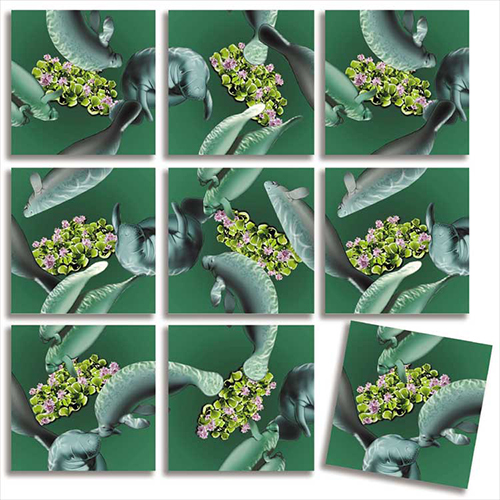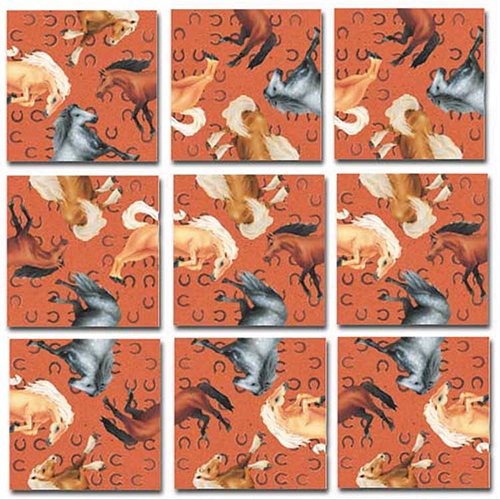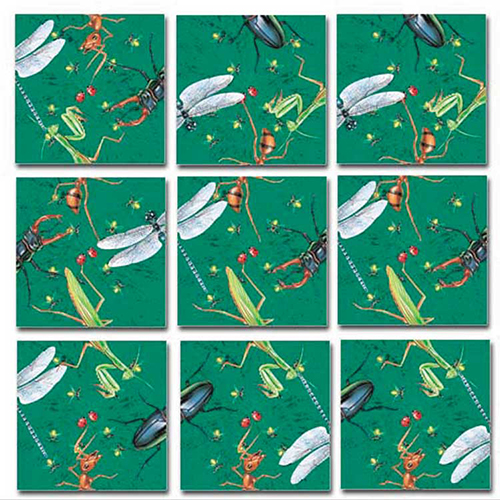Description
Facinating ‘sirens of the sea,’ the manatee is rich in folklore and a much asked for Scramble Squares® puzzle.
Fascinating Facts
Manatees and and their relatives, dugongs, are large, gentle, air breathing sea mammals that spend their entire lives in the water. They have tough and wrinkled grayish-brown skin with bristle-like hairs all over their bodies and thick whiskers on their large snouts. Organisms such as algae growing on the skin of these slow-moving animals affect their color. The most obvious difference between manatees and dugongs is that manatees have paddle-shaped tails and dugongs have tails that have pointed ends, like the tail of a whale. Both species use their tails to propel their bodies through the water. They have two limbs in the front of their bodies which they use for steering and for scooping up food. Manatees and dugongs have very small eyes, but they can see very well. They have no external ear flaps, but they can hear well. Hearing is an important sense for young manatees, because mother and calf use vocal sounds to stay together. Although it may be weaned by the end of its first year, the manatee calf remains close to its mother for up to two years. The calf is dependent on its mother not only for nutrition, but also for learning about feeding and resting areas, travel routes, and warm-water refuges. They can hold their breath for about 20 minutes, but they usually come to the surface to breathe about every three to five minutes. Manatees and dugongs can live as long as 60 years.
Manatees are nonaggressive, nonterritorial herbivores (vegetarians) of the Sirenia order, but they are not related to any other major groups of marine mammals, such as whales, dolphins and porpoises (order Cetaccea), seals, sea lions and walruses (suborder pinnipedia of the Carnivora order). They spend most of their time feeding (6 to 8 hrs.) and resting (2 to 12 hrs.). The remainder of their day is spent swimming; exploring; and socializing with other manatees by rubbing against them and exhibiting behavior that looks like kissing. The name Sirenia is derived from the sirens in Greek mythology, partly human female temptresses who lured ships into being destroyed on the rocky shore with their mesmerizing songs. Hundreds of years ago, sailors believed that manatees and dugongs were the mermaids of legends. Upon arriving in the New World in 1493, Christopher Columbus recorded in his Captain’s log that the “mermaids” were not quite as lovely as he had been led to believe!
Touch seems to be very important to manatees. Manatees participate in loosely organized, seemingly playful activities such as body surfing and follow-the-leader. Bodysurfing manatees frequently nuzzle each other and vocalize between rides, often playing for more than an hour at a time. All sirenians are found in warm tropical and subtropical waters. They prefer water above 70º F (21º C). Florida manatees, a member of the West Indian manatee family, move into warmer waters when the water temperature drops below about 68º F (20º C). Amazonian manatees are the only species of manatee that live only in fresh water. They inhabit the Amazon Basin and are found mostly in Brazil. The range of the Florida manatee is primarily the peninsula of Florida, but also extends north to Virginia and west to Mississippi. Antillean members of the West Indian manatee have a sparse distribution throughout the Caribbean along the shores of Mexico, southern Texas and northeastern South America. West African manatees range from Senegal to Angola, on the west coast of Africa. Both the West Indian and West African manatees inhabit rivers, bays, canals, estuaries, and coastal areas rich in sea grass and other vegetation. They can live in fresh water, salt water and even brackish water. West Indian manatees may be found in any waterway over 3.25’ (1 m) deep that provides a coastal access. Florida manatees rarely venture into deep ocean waters.
Florida manatees feed on over 60 species of plants including turtle grass, manatee grass, shoal grass, mangrove leaves, various algae, water hydrilla and water hyacinth. Manatees consume about 4% to 9% of their body weight in wet vegetation every day. They feed both off of the bottom and at the surface. They have even been known to break off overhanging branches, consume acorns, and haul themselves partially out of the water to eat bank vegetation. Manatees use their front flippers and large, flexible lips to manipulate vegetation. Horny, ridged pads at the front of a manatee’s palate and lower jaw break vegetation into small pieces and their molars grind the food for digestion.
All four species of sirenians are endangered or threatened. A fifth species, the Stellar’s sea cow, was discovered in 1741 and hunted for its fur to extinction by 1768.





Reviews
There are no reviews yet.